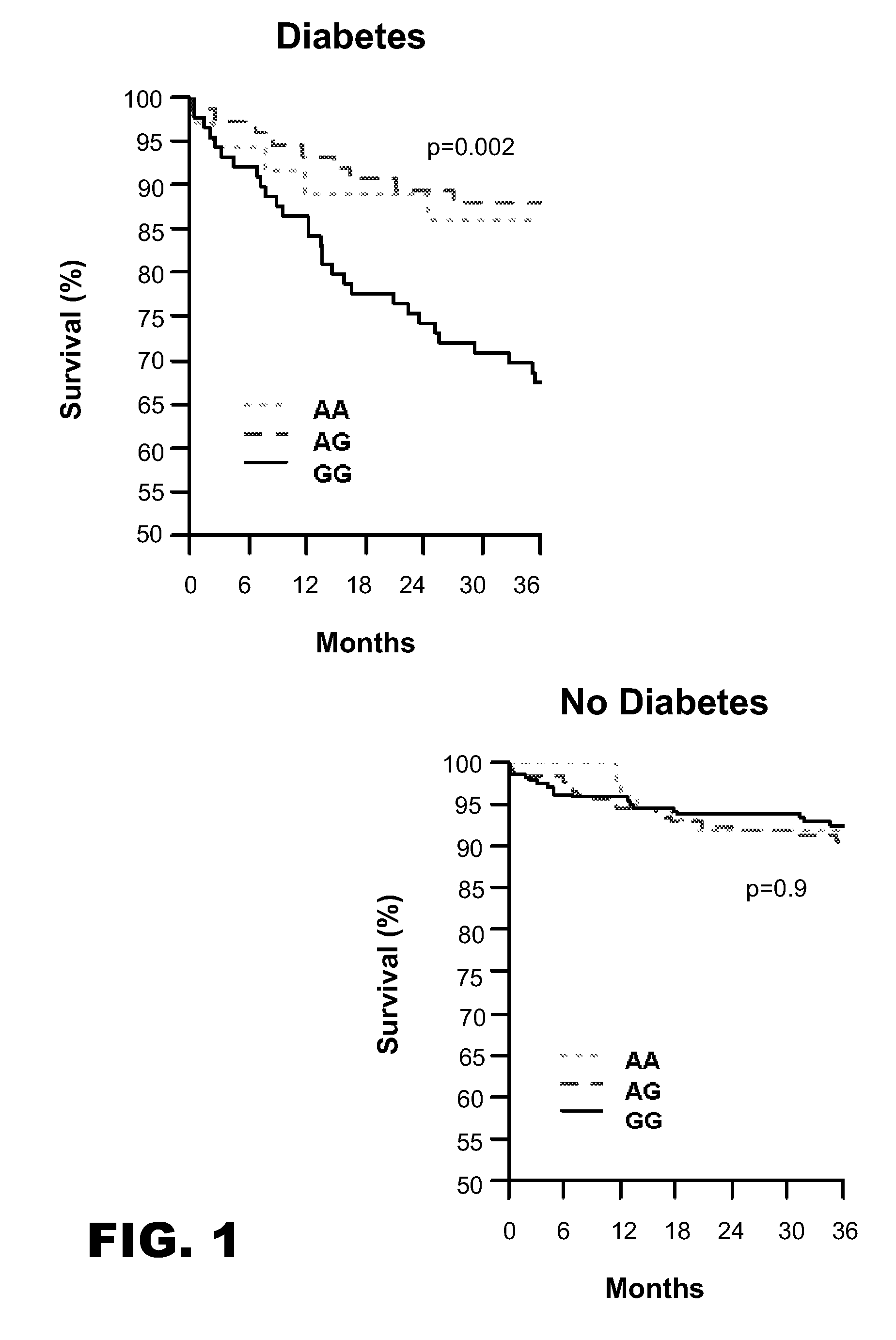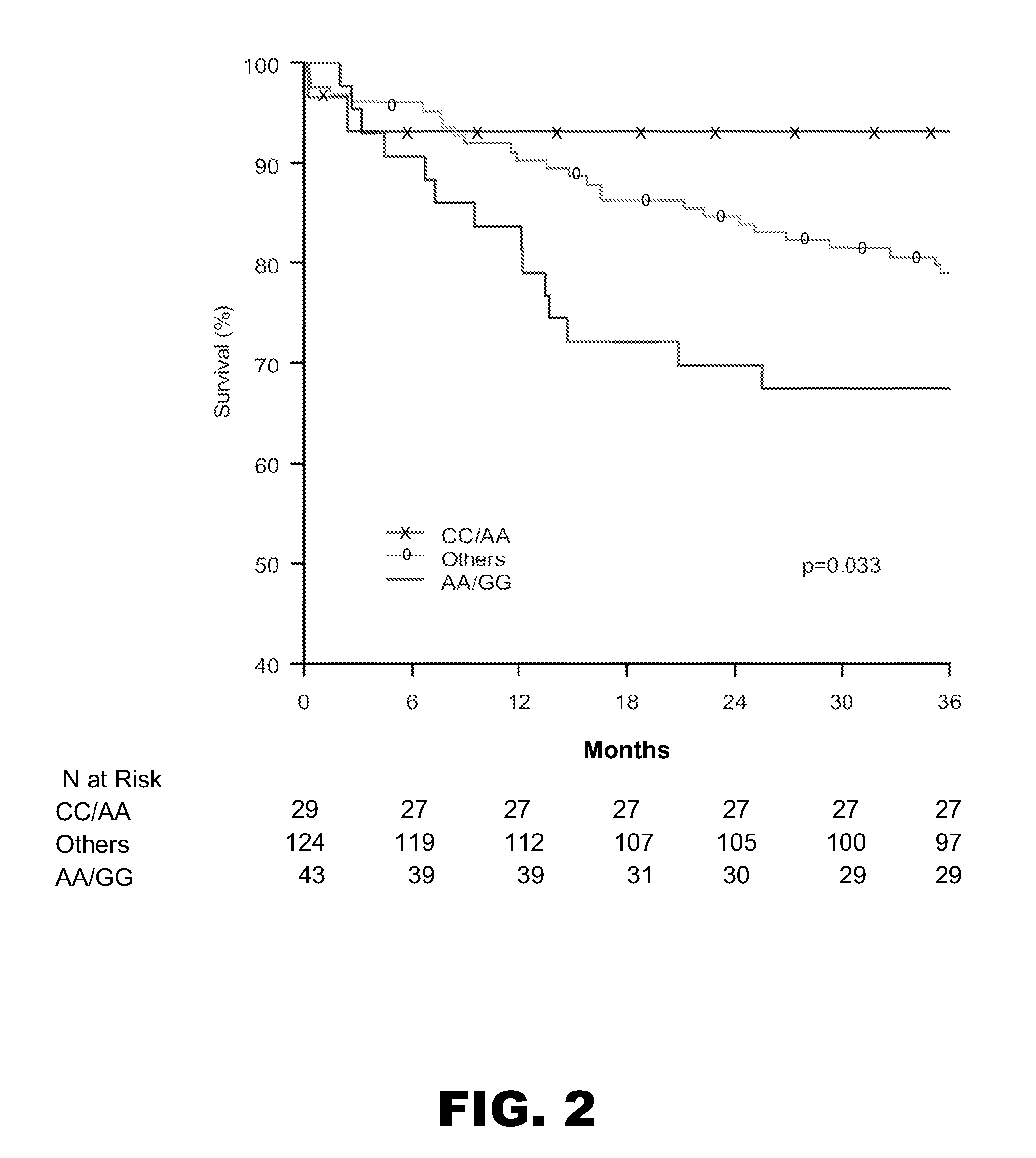Nucleotide sequence associated with acute coronary syndrome and mortality
a technology of acute coronary syndrome and nucleotide sequence, applied in the field of diagnosis and/or, can solve the problems of poor response of patients with dm to current therapies, high frequency of recurrent events, etc., and achieve the effect of different transcriptional activation and low relative binding affinity
- Summary
- Abstract
- Description
- Claims
- Application Information
AI Technical Summary
Benefits of technology
Problems solved by technology
Method used
Image
Examples
example 1
PPARA Genotypes are Associated with Increased Mortality in Diabetic ACS Patients in INFORM in a Gene-Dose Dependent Manner
[0068] The association between PPARA gene SNPs and adverse cardiovascular outcomes in patients with coronary disease was explored using the INFORM cohort. INFORM is a prospective Kansas City-based registry of ACS patients. This study enrolled 1199 patients (679 patients with a troponin-positive acute MI and 518 with unstable angina and normal troponin; 2 patients were missing information on troponin), 35% with DM, from March 2001 through October 2002. A total of 742 patients were enrolled in the genetic substudy. Two PPARA gene SNPs have been found to have significant associations in INFORM patients with DM, the PPARA −35,014 SNP and the PPARA −54,642 SNP.
[0069] DNA was isolated and extracted using the Puregene genomic DNA purification kit (Gentra, Minneapolis, Minn.). The DNA segments containing the region of interest were amplified with the polymerase chain r...
example 2
PPARA −54,642 and −35,014 Genotype is Associated with Increased Mortality in Diabetic ACS Patients in INFORM in a Gene-Dose Dependent Manner
[0075] The SNPs at −54,642 and −35,014 work together, such that patients homozygous (GG) at PPARA −54,642 and homozygous (AA) at PPARA −35,014 had a 5.7-fold relative increase in 3-year mortality (HR 5.7, CI 1.2-26.4; p=0.03), when compared to subjects homozygous for AA at PPARA −54,642 and CC at PPARA −35,014 (see FIG. 2).
example 3
The PPARA −54,642 SNP Confers Differential Binding to PPARA Activators ERRα and ERRγ
[0076] Given that the ERR nuclear receptor transcription factors bind to single consensus half site sequences and are known activators of PPARA expression, experiments were performed to determine if ERRα and ERRγ were able to bind nucleotide sequences containing the PPARA −54,642 variants.
[0077] Electromobility shift assays were performed as described by Huss et al. (Mol. Cell. Biol. 2004, 24(20):9079-91) and Cresci et al., (J. Biol. Chem. 1999, 274(36):25668-74). Complementary oligonucleotides corresponding to the region of the PPARA promoter encompassing the SNP of interest were annealed to generate double-stranded fragments used in radiolabeling and cloning. The PPARA −54,642 G variant contained a C at −54,645 and a G at −54,642, and the PPARA −54,642 A variant contained a T at −54,645 and an A at −54,642. The positive control element consisted of the previously characterized ERR responsive eleme...
PUM
| Property | Measurement | Unit |
|---|---|---|
| temperature | aaaaa | aaaaa |
| temperature | aaaaa | aaaaa |
| Tm | aaaaa | aaaaa |
Abstract
Description
Claims
Application Information
 Login to View More
Login to View More - R&D
- Intellectual Property
- Life Sciences
- Materials
- Tech Scout
- Unparalleled Data Quality
- Higher Quality Content
- 60% Fewer Hallucinations
Browse by: Latest US Patents, China's latest patents, Technical Efficacy Thesaurus, Application Domain, Technology Topic, Popular Technical Reports.
© 2025 PatSnap. All rights reserved.Legal|Privacy policy|Modern Slavery Act Transparency Statement|Sitemap|About US| Contact US: help@patsnap.com



